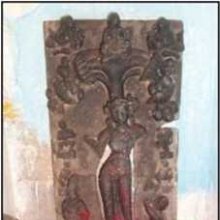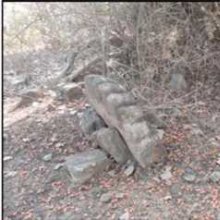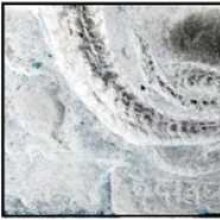Tumba: 22 definitions
Introduction:
Tumba means something in Hinduism, Sanskrit, Jainism, Prakrit, Buddhism, Pali, Marathi, Hindi, biology. If you want to know the exact meaning, history, etymology or English translation of this term then check out the descriptions on this page. Add your comment or reference to a book if you want to contribute to this summary article.
Images (photo gallery)
In Hinduism
Purana and Itihasa (epic history)
Source: Google Books: Cultural History from the Vāyu PurānaTumba (तुम्ब): a Musical Instrument.—We have no information on it from the other ancient sources. The Vāyu-purāṇa mentions it to be the pet instrument of Śiva.
Source: Cologne Digital Sanskrit Dictionaries: The Purana IndexTumba (तुम्ब).—A son of Tumba; had two sons.*
- * Brahmāṇḍa-purāṇa III. 71. 258.

The Purana (पुराण, purāṇas) refers to Sanskrit literature preserving ancient India’s vast cultural history, including historical legends, religious ceremonies, various arts and sciences. The eighteen mahapuranas total over 400,000 shlokas (metrical couplets) and date to at least several centuries BCE.
Jyotisha (astronomy and astrology)
Source: Wisdom Library: Brihat Samhita by VarahamihiraTumba (तुम्ब) or Tumbavana refers to a forest belonging to “Dakṣiṇa or Dakṣiṇadeśa (southern division)” classified under the constellations of Uttaraphālguni, Hasta and Citrā, according to the system of Kūrmavibhāga, according to the Bṛhatsaṃhitā (chapter 14), an encyclopedic Sanskrit work written by Varāhamihira mainly focusing on the science of ancient Indian astronomy astronomy (Jyotiṣa).—Accordingly, “The countries of the Earth beginning from the centre of Bhāratavarṣa and going round the east, south-east, south, etc., are divided into 9 divisions corresponding to the 27 lunar asterisms at the rate of 3 for each division and beginning from Kṛttikā. The constellations of Uttaraphālguni, Hasta and Citrā represent the southern division consisting of [i.e., Tumba-vana] [...]”.

Jyotisha (ज्योतिष, jyotiṣa or jyotish) refers to ‘astronomy’ or “Vedic astrology” and represents the fifth of the six Vedangas (additional sciences to be studied along with the Vedas). Jyotisha concerns itself with the study and prediction of the movements of celestial bodies, in order to calculate the auspicious time for rituals and ceremonies.
In Jainism
General definition (in Jainism)
Source: Wisdom Library: JainismTumba (तुम्ब) refers to the “gourd”: a type of vegetable (śāka), according to The Vyākhyāprajñapti 7.3.276. It is also known as Tumba. Different kinds of vegetables were grown in the vegetable gardens (kaccha / kakṣa). The consumption of vegetables was considered essential for digesting food according to the Niśīthacūrṇi. The Jaina texts forbid the consumption of certain vegetables as it leads to killing of insects.
The Vyākhyāprajñapti, also known as the Bhagavatīsūtra contains a compilation of 36,000 questions answered by Mahāvīra and dates to at least the 1st century A.D. The Niśīthacūrṇi by Jinadāsa is a 7th century commentary on the Niśthasūtra and deals with Jain medical knowledge.

Jainism is an Indian religion of Dharma whose doctrine revolves around harmlessness (ahimsa) towards every living being. The two major branches (Digambara and Svetambara) of Jainism stimulate self-control (or, shramana, ‘self-reliance’) and spiritual development through a path of peace for the soul to progess to the ultimate goal.
Biology (plants and animals)
Source: Wisdom Library: Local Names of Plants and DrugsTumba in the Malayalam language is the name of a plant identified with Leucas aspera (Willd.) Link from the Lamiaceae (Mint) family. For the possible medicinal usage of tumba, you can check this page for potential sources and references, although be aware that any some or none of the side-effects may not be mentioned here, wether they be harmful or beneficial to health.
Tumba in the Malayalam language is the name of a plant identified with Leucas cephalotes (Roth) Spreng. from the Lamiaceae (Mint) family having the following synonyms: Leucas capitata, .
Source: Google Books: CRC World Dictionary (Regional names)1) Tumba in India is the name of a plant defined with Citrullus colocynthis in various botanical sources. This page contains potential references in Ayurveda, modern medicine, and other folk traditions or local practices It has the synonym Colocynthis vulgaris Schrad. (among others).
2) Tumba is also identified with Lagenaria siceraria It has the synonym Cucurbita idolatrica Willd. (etc.).
3) Tumba is also identified with Leucas aspera It has the synonym Phlomis esculenta Roxb. (etc.).
4) Tumba is also identified with Thymus serpyllum It has the synonym Thymus serpyllum subsp. pycnotrichus Uechtr. (etc.).
Example references for further research on medicinal uses or toxicity (see latin names for full list):
· Index Seminum [Goettingen] (1833)
· Flora of the British India (1885)
· J. Cytol. Genet. (1996)
· Garcia Orta, Sér. Bot. (1976)
· Linnaea (1838)
· Mémoires de la Société de Physique et d’Histoire Naturelle de Genève (1825)
If you are looking for specific details regarding Tumba, for example extract dosage, side effects, chemical composition, pregnancy safety, health benefits, diet and recipes, have a look at these references.

This sections includes definitions from the five kingdoms of living things: Animals, Plants, Fungi, Protists and Monera. It will include both the official binomial nomenclature (scientific names usually in Latin) as well as regional spellings and variants.
Languages of India and abroad
Pali-English dictionary
Source: BuddhaSasana: Concise Pali-English Dictionarytumba : (m.; nt.) a kind of water-vessel; a measure used for grain.
Source: Sutta: The Pali Text Society's Pali-English DictionaryTumba, (m. nt.) (possibly=Sk. tumra swollen (of shape), same root as tumula) 1. a kind of water vessel (udaka° DA. I, 202), made of copper, wood or a fruit (like a calabash, cocoanut, etc., cp. kaṭāha, E. skull) Vin. I, 205 (loha°, kaṭṭha°, phala°); II, 114 (°kaṭāha of gourd); J. III, 430 (udaka°); IV, 114; DhA. II, 193 (udaka°).—2. a measure of capacity, esp. used for grain J. I, 233 (mahā°), 467 (=4 nāḷi p. 468); Miln. 102. (Page 305)

Pali is the language of the Tipiṭaka, which is the sacred canon of Theravāda Buddhism and contains much of the Buddha’s speech. Closeley related to Sanskrit, both languages are used interchangeably between religions.
Marathi-English dictionary
Source: DDSA: The Molesworth Marathi and English Dictionarytumba (तुंब).—n The cogged wheel belonging to a water-wheel. 2 The nave of a wheel. 3 A dam across a river. 4 R Commonly tumbārā.
--- OR ---
tumbā (तुंबा).—m (S) The long white gourd (Cucurbita lagenaris), or a bowl or vessel made of it. 2 The bowl or socket (place where the shaft is inserted) of certain weapons or implements. 3 The head or back-part of a hoe, hammer, ax, adz &c. 4 (Or tumba) The nave of a wheel. 5 (For tumāna) Trowsers of a large or loose make. 6 A low and spreading bush. The flowers are offered to Shiva, and the leaves are used medicinally, Ipomœa turpethum. Grah. See dudhāṇī. 7 Usually tumbārā.
Source: DDSA: The Aryabhusan school dictionary, Marathi-Englishtumbā (तुंबा).—m The long white gourd. The vessel made of it. The nave of a wheel.
Marathi is an Indo-European language having over 70 million native speakers people in (predominantly) Maharashtra India. Marathi, like many other Indo-Aryan languages, evolved from early forms of Prakrit, which itself is a subset of Sanskrit, one of the most ancient languages of the world.
Sanskrit dictionary
Source: DDSA: The practical Sanskrit-English dictionaryTumba (तुम्ब).—[tumba-ac] A kind of gourd.
-tumbā 1 A kind of long gourd.
2) A milch cow.
3) milk-vessel.
Derivable forms: tumbaḥ (तुम्बः).
Source: Cologne Digital Sanskrit Dictionaries: Shabda-Sagara Sanskrit-English DictionaryTumba (तुम्ब).—mf. (-mbaḥ-mbā or -mbī) A long gourd, &c. See tumbi. f.
(-mbā) a cow disposed to be milked. E. tubi to destroy, (bile, &c.) affix ac.
Source: Cologne Digital Sanskrit Dictionaries: Benfey Sanskrit-English DictionaryTumba (तुम्ब).—m. and f. bī, A long gourd, Lagenaria vulgaris, [Rāmāyaṇa] 1, 39, 7 Ser.; [Suśruta] 1, 183, 17.
Source: Cologne Digital Sanskrit Dictionaries: Cappeller Sanskrit-English DictionaryTumba (तुम्ब).—[masculine] ī [feminine] a kind of long gourd.
Source: Cologne Digital Sanskrit Dictionaries: Monier-Williams Sanskrit-English Dictionary1) Tumba (तुम्ब):—m. the gourd Lagenaria vulgaris, [Harivaṃśa 3479; Rāmāyaṇa i; Suśruta iii]
2) Tumbā (तुम्बा):—[from tumba] f. a milk-pail, [cf. Lexicographers, esp. such as amarasiṃha, halāyudha, hemacandra, etc.]
Source: Cologne Digital Sanskrit Dictionaries: Yates Sanskrit-English DictionaryTumba (तुम्ब):—(mbaḥ) 1. m. A long gourd. f. (mbā) A cow disposed to be milked.
Source: DDSA: Paia-sadda-mahannavo; a comprehensive Prakrit Hindi dictionary (S)Tumba (तुम्ब) in the Sanskrit language is related to the Prakrit words: Tuṃba, Tubaṃ, Tuṃbā.
[Sanskrit to German]
Sanskrit, also spelled संस्कृतम् (saṃskṛtam), is an ancient language of India commonly seen as the grandmother of the Indo-European language family (even English!). Closely allied with Prakrit and Pali, Sanskrit is more exhaustive in both grammar and terms and has the most extensive collection of literature in the world, greatly surpassing its sister-languages Greek and Latin.
Hindi dictionary
Source: DDSA: A practical Hindi-English dictionaryTuṃbā (तुंबा):—(nm) a gourd; a pot made out of scooped gourd; hence [tuṃbī] (nf).
...
Prakrit-English dictionary
Source: DDSA: Paia-sadda-mahannavo; a comprehensive Prakrit Hindi dictionary1) Tuṃba (तुंब) in the Prakrit language is related to the Sanskrit word: Tumba.
2) Tuṃbā (तुंबा) also relates to the Sanskrit word: Tumbā.
Prakrit is an ancient language closely associated with both Pali and Sanskrit. Jain literature is often composed in this language or sub-dialects, such as the Agamas and their commentaries which are written in Ardhamagadhi and Maharashtri Prakrit. The earliest extant texts can be dated to as early as the 4th century BCE although core portions might be older.
Kannada-English dictionary
Source: Alar: Kannada-English corpusTuṃba (ತುಂಬ):—[noun] abundance; abundant quantity; profusion.
--- OR ---
Tuṃba (ತುಂಬ):—[adverb] in large quantities, numbers, degree, amount, etc.; abundantly; amply; excessively.
--- OR ---
Tuṃba (ತುಂಬ):—[noun] the large, round, edible fruit of the vine Cucurbita maxima (of Cucurbitaceae family).
--- OR ---
Tuṃba (ತುಂಬ):—
1) [adjective] existing in ample quantity or number; plentiful; abundant; plenty.
2) [adjective] more than sufficient; ample; plenty.
--- OR ---
Tuṃbā (ತುಂಬಾ):—[adverb] = ತುಂಬ [tumba]2.
Kannada is a Dravidian language (as opposed to the Indo-European language family) mainly spoken in the southwestern region of India.
See also (Relevant definitions)
Starts with (+17): Tumba-codiveli, Tumba-djali, Tumbabana, Tumbadi, Tumbadibava, Tumbae, Tumbaga, Tumbai, Tumbai-cheddi, Tumbajoda, Tumbaka, Tumbakataha, Tumbaki, Tumbakya, Tumbala, Tumbalaka, Tumbalanem, Tumbali, Tumbaluha, Tumbanem.
Ends with (+14): Avibhaktakutumba, Carim-tumba, Ekatumba, Gartumba, Gattatumba, Gorakhatumba, Kacatumba, Kappattumba, Karintumba, Katthatumba, Katu-tumba, Kautumba, Kolikutumba, Kotumba, Kudukutumba, Kulakutumba, Kustumba, Kutumba, Mahakutumba, Mutumba.
Full-text (+25): Tumbavana, Tumbi, Tumbaka, Tumbuka, Tumbini, Tumbika, Tumbavina, Tumba-codiveli, Umana tumba, Carim-tumba, Tumba-djali, Tumbabana, Tumbavarca, Tumpalai, Tumbivina, Tubam, Tumbajoda, Ekatumba, Tumbara, Dantekada.
Relevant text
Search found 11 books and stories containing Tumba, Tumbā, Tuṃbā, Tuṃba; (plurals include: Tumbas, Tumbās, Tuṃbās, Tuṃbas). You can also click to the full overview containing English textual excerpts. Below are direct links for the most relevant articles:
Vinaya (3): The Cullavagga (by T. W. Rhys Davids)
Cullavagga, Khandaka 5, Chapter 10 < [Khandaka 5 - On the Daily Life of the Bhikkhus]
Yoga Vasistha [English], Volume 1-4 (by Vihari-Lala Mitra)
Chapter xxxvi < [Book III - Utpatti khanda (utpatti khanda)]
Bhagavati-sutra (Viyaha-pannatti) (by K. C. Lalwani)
Chapter 10: Indras’ assemblies < [Book 3]
The Skanda Purana (by G. V. Tagare)
Chapter 1 - Nārada’s Vision of Yajñavarāha (Stationed on the Peak of Sumeru) < [Section 1 - Veṅkaṭācala-māhātmya]
Jain Remains of Ancient Bengal (by Shubha Majumder)
Jainism in ancient Bengal during the early medieval period < [Chapter 3 - Historical Background of Jainism in Ancient Bengal]
Abandoned Temples/Structural Ruins Containing Sculptural Specimens < [Chapter 5 - Jaina Architectural and Sculptural Remains]
Śāsanadevīs or Yakṣiṇīs from Ancient Bengal < [Chapter 6 - Iconographic Study of Jaina Sculptural Remains]
Kautilya Arthashastra (by R. Shamasastry)
Chapter 3 - The Application of Medicines and Mantras < [Book 14 - Secret Means]


